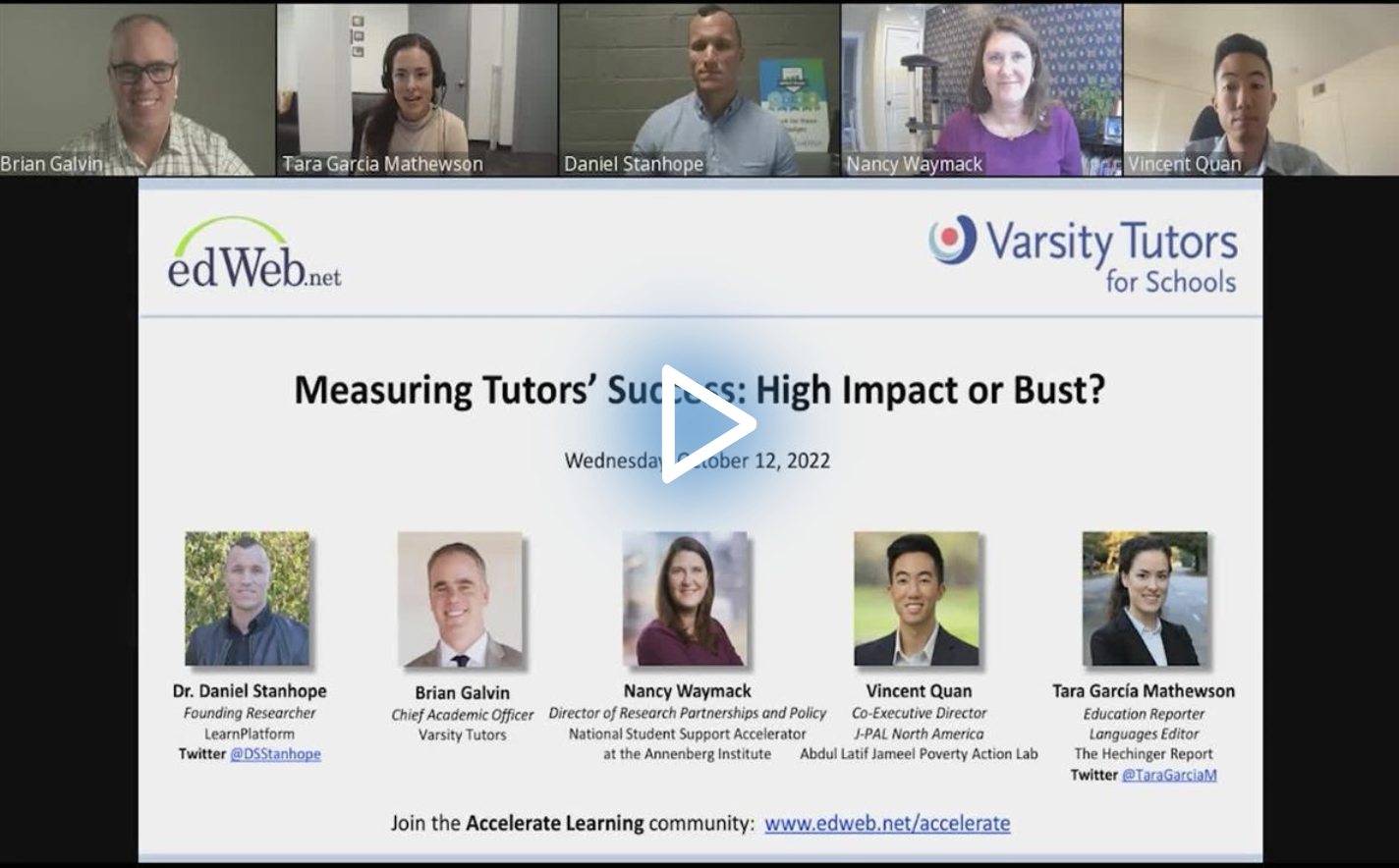Measuring Tutoring Success for Learning Recovery
Watch the Recording Listen to the Podcast
During the edLeader Panel, “Measuring Tutors’ Success: High Impact or Bust,” the presenters discussed the benefits of tutoring and how to take a data-informed approach to deploying, evaluating, and refining a learning recovery strategy.
What is high-impact tutoring?
High-impact tutoring is a form of teaching 1:1 or in a small group in order to achieve a specific goal. Its characteristics include substantial time each week spent with a consistent tutor and monitoring of students’ progress. Excellent tutoring programs include training for staff to ensure high-quality, safe, and equitable interactions with students.
Is there proof of the efficacy of face-to-face tutoring?
The positive impact of face-to-face tutoring has been documented by many studies. J-PAL North America examined 96 RCT studies that measured the efficacy of face-to-face tutoring, and across the board, they found that high-quality tutoring programs improve learning outcomes. In fact, it was proven that participation in such a program is linked to an approximately one-year gain in academic level for students. With certain factors influencing the results—for example, frequency of tutoring, quality of tutors, size of groups, and length of tutoring sessions—overall, tutoring was an effective intervention to catch students up.
Is virtual tutoring as effective as in-person tutoring?
As virtual tutoring is a newer format, it has been less studied. However, emerging studies show virtual tutoring has a significant positive impact on students. This is because there are design principles and factors that are universal and can be applied in both a remote or in-person model. The most important element of evaluating any tutoring program is to collect data and analyze literature to be sure that programs are using top-notch pedagogy, applying best practices, and consistently evaluating outcomes to be sure that they are reaching desired goals.
What should districts be mindful of when implementing tutoring programs?
All districts should begin by defining their goals and ideal outcomes. Then, they can focus on the question: how can we make this program as accessible as possible so students will attend? How will we support teachers, administrative staff, students, and families in our program design and implementation?
Then, choosing which students align with the district’s goals for the tutoring program is crucial to the program’s success. Designing for their reality is also crucial—though after-school programs are popular, students who most need interventions often don’t attend because it requires additional transportation logistics that families cannot provide. Thinking through those logistics is challenging for schools, but can ultimately make or break a program. Additionally, showing the value of progress through information sharing with tutors, teachers, and families has been shown to increase stakeholder engagement.
How should districts track the success of the tutoring sessions?
The first step is to define the goals and desired outcomes. For example, is the school focused on social-emotional outcomes, pure academic gains, or remedying learning loss? Then, the program can be designed around this mission. Once the program has launched, it is crucial to follow a data-monitoring process or use a randomized control trial (RCT) to measure the efficacy of the program. In the case of an RCT, this process should be managed by an independent research partner. Important stats to track include who gave and who received tutoring, what students learned, and how students demonstrated knowledge. Lastly, it is crucial to loop data from the tutoring program back into the district’s databases so that knowledge is captured and all stakeholders are in communication for the benefit of the students.
What are the best options for data-collection tools?
While there are many tools on the market, the key to choosing a great one is focusing on validity, reliability, and fairness, with external measures that have been validated. Then, district leaders must focus on what type of data to collect and how to collect it. Any tool should be consistently used as often as possible and generate actionable data that links to outcomes associated with a logic model. There are three types of data to prioritize:
- Usage/engagement data
- Outcomes data
- Covariance data, including demographics, lunch status, and urbanity, that is important to understand what’s working for whom and under what conditions
What should teachers take into account for student needs?
Students thrive on routines. Making sure that the value is clear to them, it’s easy to access on a practical level, and that students’ progress is clearly demonstrated are all crucial to ensure their engagement. Building relationships with the tutor also helps with engagement which leads to improved outcomes. Making sure that tutors are empowered to build logical learning plans and able to diagnose weaknesses is key to getting to the root cause of learning loss. Then, it is important to communicate throughout the process with stakeholders (parents and teachers) to make sure progress is built on and reinforced at various levels.
How can you use data to select which students would get the greatest impact from tutoring?
The first step is to focus on the goal of your tutoring program. For example, if the goal is to catch students up with learning, then program leaders would want to look for the students who have been falling behind. Then, understand what can reasonably be taken on as a district given the available resources. Programs should begin by prioritizing high-dosage tutoring first to the students whose realities are most closely tied to the goals of the program. (High-dosage tutoring is defined as three to five times per week, at least 30 minutes per session, with a consistent and trained tutor.) Once the program is clearly defined and structured, districts can begin analyzing data and creating strategies to expand the program in a sustainable way.
Best practices for research-practice partnerships
As many ecosystem builders become more interested in the efficacy of high-impact tutoring programs, schools have an opportunity to partner with organizations that sponsor and provide resources in exchange for the ability to perform studies. When greenlighting such a program, districts need to consider data privacy standards, the independence of the researching committee, and adherence to best impact-evaluation measures, showing a commitment to data-collection measures.
Q&A Takeaways
- When should tutoring happen? Ideally, tutoring should happen during the school day because students are most likely to show up. However, if the only option is after-school tutoring, districts can explore opportunities to provide transportation for students.
- What is the ideal group size? Student to tutor ratio is important. Younger students tend to benefit more from 1:1 tutoring, whereas older students do better in smaller groups.
- Are high-impact tutoring programs for IEPs and homework help, or something else? An IEP executed in a resource room, or homework help, are interventions that can add value to a student’s journey as well, but they are different from high-impact tutoring programs. Ideally, high-impact tutoring is a supplement to the first-degree teaching that is happening in the classroom.
Learn more about this edWeb broadcast, “Measuring Tutors’ Success: High Impact or Bust,” sponsored by Varsity Tutors.
Watch the Recording Listen to the Podcast
Join the Community
Accelerate Learning is a free professional learning community that helps educators learn and share ideas for meeting students where they are in their learning and accelerating their progress.
Varsity Tutors for Schools is your all-in-one live learning platform that delivers personalized learning to every student in your school district. Whatever challenges your students face, our proven solutions can be customized to meet their needs, providing equitable access to everything from on-demand to 1-on-1 high-impact tutoring to adaptive assessments.
Blog post by Laura Smulian, based on this edLeader Panel






Comments are closed.